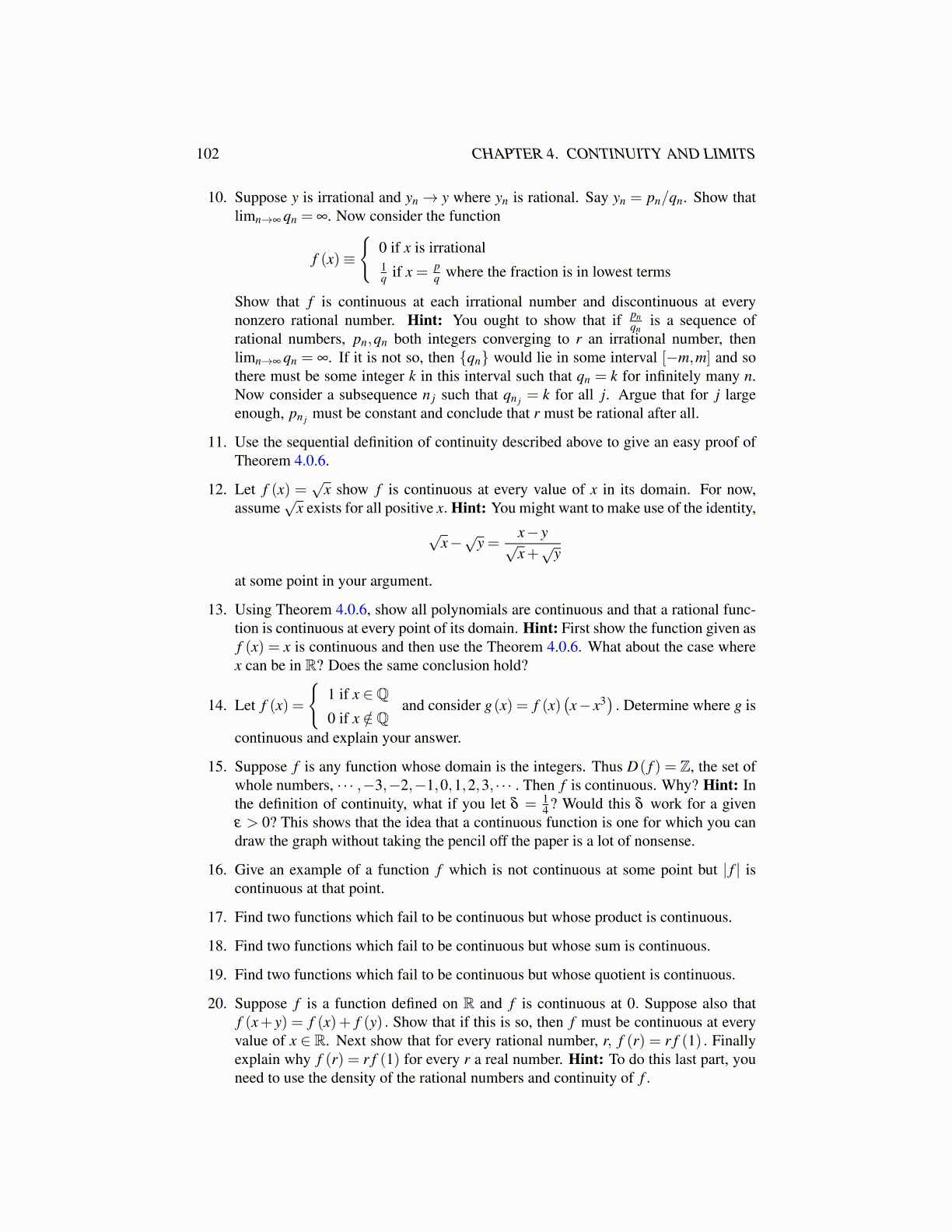
102 CHAPTER 4. CONTINUITY AND LIMITS
10. Suppose y is irrational and yn → y where yn is rational. Say yn = pn/qn. Show thatlimn→∞ qn = ∞. Now consider the function
f (x)≡
{0 if x is irrational1q if x = p
q where the fraction is in lowest terms
Show that f is continuous at each irrational number and discontinuous at everynonzero rational number. Hint: You ought to show that if pn
qnis a sequence of
rational numbers, pn,qn both integers converging to r an irrational number, thenlimn→∞ qn = ∞. If it is not so, then {qn} would lie in some interval [−m,m] and sothere must be some integer k in this interval such that qn = k for infinitely many n.Now consider a subsequence n j such that qn j = k for all j. Argue that for j largeenough, pn j must be constant and conclude that r must be rational after all.
11. Use the sequential definition of continuity described above to give an easy proof ofTheorem 4.0.6.
12. Let f (x) =√
x show f is continuous at every value of x in its domain. For now,assume
√x exists for all positive x. Hint: You might want to make use of the identity,
√x−√
y =x− y√x+
√y
at some point in your argument.
13. Using Theorem 4.0.6, show all polynomials are continuous and that a rational func-tion is continuous at every point of its domain. Hint: First show the function given asf (x) = x is continuous and then use the Theorem 4.0.6. What about the case wherex can be in R? Does the same conclusion hold?
14. Let f (x) =
{1 if x ∈Q0 if x /∈Q
and consider g(x) = f (x)(x− x3
). Determine where g is
continuous and explain your answer.
15. Suppose f is any function whose domain is the integers. Thus D( f ) = Z, the set ofwhole numbers, · · · ,−3,−2,−1,0,1,2,3, · · · . Then f is continuous. Why? Hint: Inthe definition of continuity, what if you let δ = 1
4 ? Would this δ work for a givenε > 0? This shows that the idea that a continuous function is one for which you candraw the graph without taking the pencil off the paper is a lot of nonsense.
16. Give an example of a function f which is not continuous at some point but | f | iscontinuous at that point.
17. Find two functions which fail to be continuous but whose product is continuous.
18. Find two functions which fail to be continuous but whose sum is continuous.
19. Find two functions which fail to be continuous but whose quotient is continuous.
20. Suppose f is a function defined on R and f is continuous at 0. Suppose also thatf (x+ y) = f (x)+ f (y) . Show that if this is so, then f must be continuous at everyvalue of x ∈ R. Next show that for every rational number, r, f (r) = r f (1) . Finallyexplain why f (r) = r f (1) for every r a real number. Hint: To do this last part, youneed to use the density of the rational numbers and continuity of f .